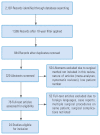Comparison of Different Approaches in Lumbosacral Spinal Fusion Surgery: A Systematic Review and Meta-Analysis
- PMID: 33389967
- PMCID: PMC8873994
- DOI: 10.31616/asj.2020.0405
Comparison of Different Approaches in Lumbosacral Spinal Fusion Surgery: A Systematic Review and Meta-Analysis
Abstract
We aimed to systematically review the literature to analyze the differences in posterior lumbar interbody fusion (PLIF), anterior lumbar interbody fusion (ALIF), and transforaminal lumbar interbody fusion (TLIF), focusing on the complications, risk factors, and fusion rate of each approach. Spinal fusion surgery is a well-established surgical procedure for a variety of indications, and different approaches developed. The various approaches and their advantages, as well as approach-related pathology and complications, are well investigated in spinal surgery. Focusing only on lumbosacral fusion, the comparative studies of different approaches remain fewer in numbers. We systematically reviewed the literature on the complications associated with lumbosacral interbody fusion. Only the PLIF, ALIF, or TLIF approaches and studies published within the last decade (2007-2017) were included. The exclusion criteria in this study were oblique lumbar interbody fusion, extreme lateral interbody fusion, more than one procedure per patient, and reported patient numbers less than 10. The outcome variables were indications, fusion rates, operation time, perioperative complications, and clinical outcome by means of Visual Analog Scale, Oswestry Disability Index, and Japanese Orthopaedic Association score. Five prospective, 17 retrospective, and two comparative studies that investigated the lumbosacral region were included. Mean fusion rates were 91,4%. ALIF showed a higher operation time, while PLIF resulted in greater blood loss. In all approaches, significant improvements in the clinical outcome were achieved, with ALIF showing slightly better results. Regarding complications, the ALIF technique showed the highest complication rates. Lumbosacral fusion surgery is a treatment to provide good results either through an approach for various indications as causes of lower back pain. For each surgical approach, advantages can be depicted. However, perioperative complications and risk factors are numerous and vary with ALIF, PLIF, and TLIF procedures, as well as with fusion rates.
Keywords: Anterior lumbar interbody fusion; Complications; L5/S1 fusion; Posterior lumbar interbody fusion; Risk factors; Transforaminal lumbar interbody fusion.
Conflict of interest statement
No potential conflict of interest relevant to this article was reported.
Figures
Similar articles
-
Comparative analysis of 3 surgical strategies for adult spinal deformity with mild to moderate sagittal imbalance.J Neurosurg Spine. 2018 Jan;28(1):40-49. doi: 10.3171/2017.5.SPINE161370. Epub 2017 Nov 3. J Neurosurg Spine. 2018. PMID: 29087808
-
A meta-analysis comparing ALIF, PLIF, TLIF and LLIF.J Clin Neurosci. 2017 Oct;44:11-17. doi: 10.1016/j.jocn.2017.06.013. Epub 2017 Jul 1. J Clin Neurosci. 2017. PMID: 28676316
-
Functional and radiological outcome of anterior retroperitoneal versus posterior transforaminal interbody fusion in the management of single-level lumbar degenerative disease.Neurosurg Focus. 2020 Sep;49(3):E2. doi: 10.3171/2020.6.FOCUS20374. Neurosurg Focus. 2020. PMID: 32871567
-
ALIF vs. posterior fusion for lumbar degenerative disease: comparable efficacy but elevated risk of severe complications-a systematic review and meta-analysis.Eur Spine J. 2025 May 22. doi: 10.1007/s00586-025-08914-w. Online ahead of print. Eur Spine J. 2025. PMID: 40402235 Review.
-
Radiographic and Clinical Outcomes of Anterior and Transforaminal Lumbar Interbody Fusions: A Systematic Review and Meta-analysis of Comparative Studies.Clin Spine Surg. 2018 May;31(4):E230-E238. doi: 10.1097/BSD.0000000000000549. Clin Spine Surg. 2018. PMID: 28622187
Cited by
-
Spinal Deformity, Surgery at the Cervicothoracic Junction, and American Society of Anesthesiologists Class Increase the Risk of Post-surgical Intensive Care Unit Treatment after Dorsal Spine Surgery: A Single-Center Multivariate Analysis of 962 Patients.Asian Spine J. 2023 Dec;17(6):1035-1042. doi: 10.31616/asj.2023.0093. Epub 2023 Nov 10. Asian Spine J. 2023. PMID: 37946337 Free PMC article.
-
Prospective Assessment of Transforaminal Lumbar Interbody Fusion (TLIF) in Spondylolisthesis: A Radiological and Functional Outcome Study in an Indian Population.Cureus. 2024 Aug 26;16(8):e67880. doi: 10.7759/cureus.67880. eCollection 2024 Aug. Cureus. 2024. PMID: 39328682 Free PMC article.
-
Adjacent Segment Motion of Stand-Alone ALIF Versus TLIF in the Degenerative Spine: A Biomechanical Study.Global Spine J. 2025 May 14:21925682251341823. doi: 10.1177/21925682251341823. Online ahead of print. Global Spine J. 2025. PMID: 40365962 Free PMC article.
-
Anterior Thigh Pain Following Minimally Invasive Oblique Lateral Interbody Fusion: Multivariate Analysis from a Prospective Case Series.Clin Orthop Surg. 2022 Sep;14(3):401-409. doi: 10.4055/cios21250. Epub 2022 Jul 21. Clin Orthop Surg. 2022. PMID: 36061851 Free PMC article.
-
Radiographic Robustness of Lumbar Interbody Fusion Techniques.Global Spine J. 2025 Jan;15(1):59-65. doi: 10.1177/21925682241226659. Epub 2024 Jan 10. Global Spine J. 2025. PMID: 38197369 Free PMC article.
References
-
- Rajaee SS, Bae HW, Kanim LE, Delamarter RB. Spinal fusion in the United States: analysis of trends from 1998 to 2008. Spine (Phila Pa 1976) 2012;37:67–76. - PubMed
-
- Dorward IG, Lenke LG, Bridwell KH, et al. Transforaminal versus anterior lumbar interbody fusion in long deformity constructs: a matched cohort analysis. Spine (Phila Pa 1976) 2013;38:E755–62. - PubMed
-
- Mobbs RJ, Phan K, Assem Y, Pelletier M, Walsh WR. Combination Ti/PEEK ALIF cage for anterior lumbar interbody fusion: early clinical and radiological results. J Clin Neurosci. 2016;34:94–9. - PubMed
LinkOut - more resources
Full Text Sources
Other Literature Sources


